Other name(s) Hedjaz Railway Closed 1920 (1920) | Opened 1908 (1908) Track length 1,320 km (820 mi) | |
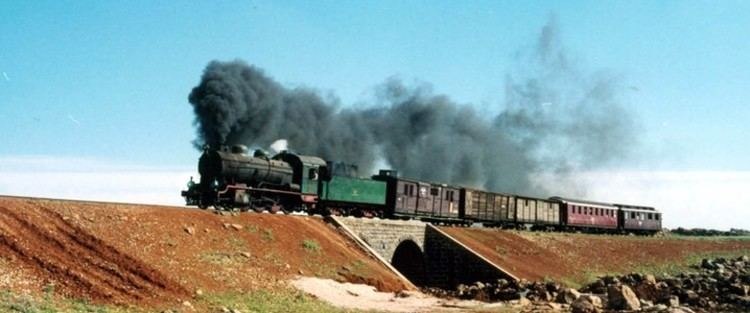 | ||
Track gauge 1,050 mm (3 ft 5 ⁄32 in) Operators Hedjaz Jordan Railway, Chemin de Fer de Hedjaz Syrie | ||
Jordan hejaz railway
The Hejaz (or Hedjaz) Railway (Turkish: Hicaz Demiryolu) was a narrow gauge railway (1,050 mm/3 ft 5 11⁄32 in track gauge) that ran from Damascus to Medina, through the Hejaz region of Saudi Arabia, with a branch line to Haifa on the Mediterranean Sea. It was a part of the Ottoman railway network and was built to extend the line from the Haydarpaşa Terminal in Kadikoy beyond Damascus to the holy city of Mecca. It got no further than Medina, 400 kilometres (250 mi) short of Mecca, due to the interruption of the construction works caused by the outbreak of World War I. Damascus to Medina is 1,300 kilometres (810 mi).
Contents
- Jordan hejaz railway
- Hejaz railway jordan s heritage train arab revolution show tourist attraction
- Construction
- Arrival in Medina
- Attacks on the railway
- World War I
- World War II
- The 1960s
- Current status
- References
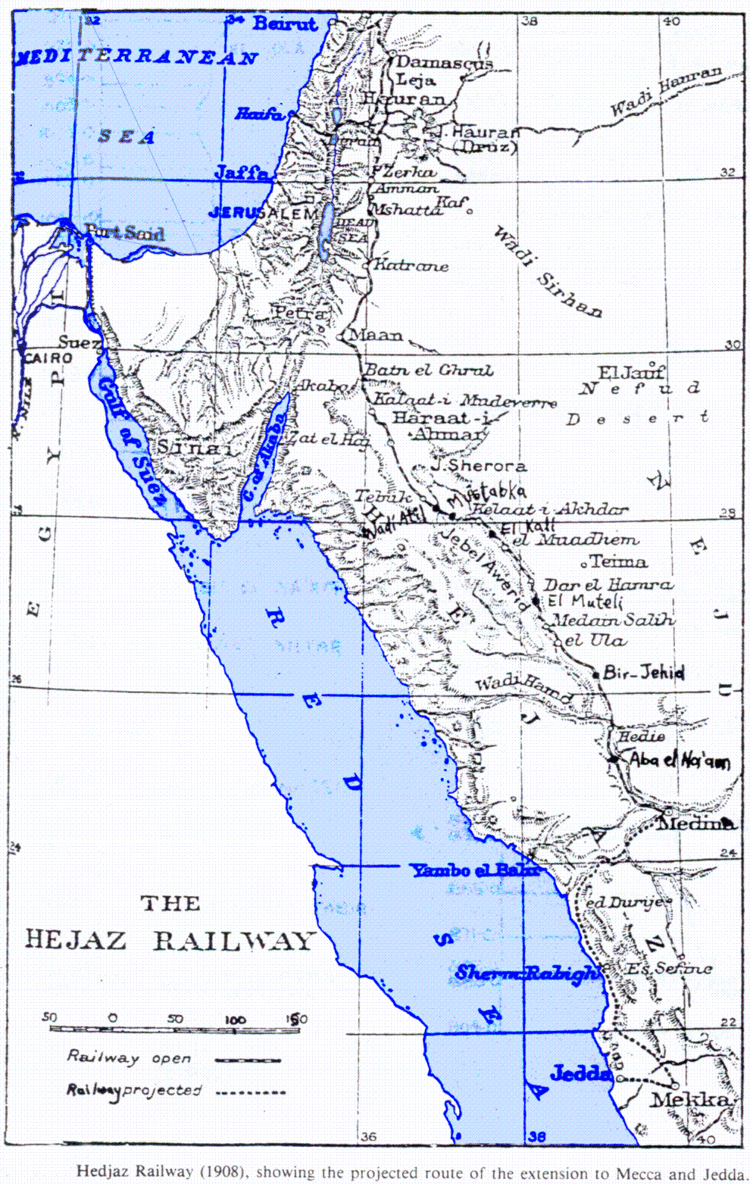
The main purpose of the railway was to establish a connection between Constantinople, the capital of the Ottoman Empire and the seat of the Islamic Caliphate, and Hejaz in Arabia, the site of the holiest shrines of Islam and the holy city of Mecca, the destination of the Hajj annual pilgrimage. Another important reason was to improve the economic and political integration of the distant Arabian provinces into the Ottoman state, and to facilitate the transportation of military forces.
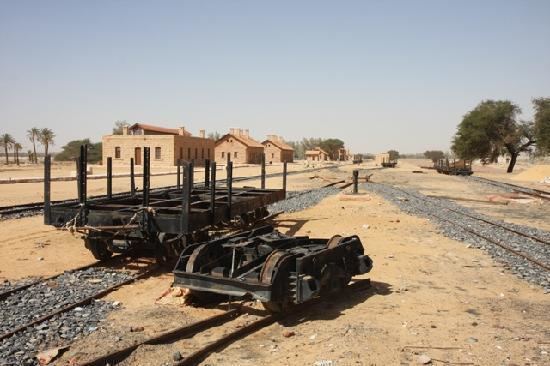
The railway had no debt when completed.
Hejaz railway jordan s heritage train arab revolution show tourist attraction
Construction
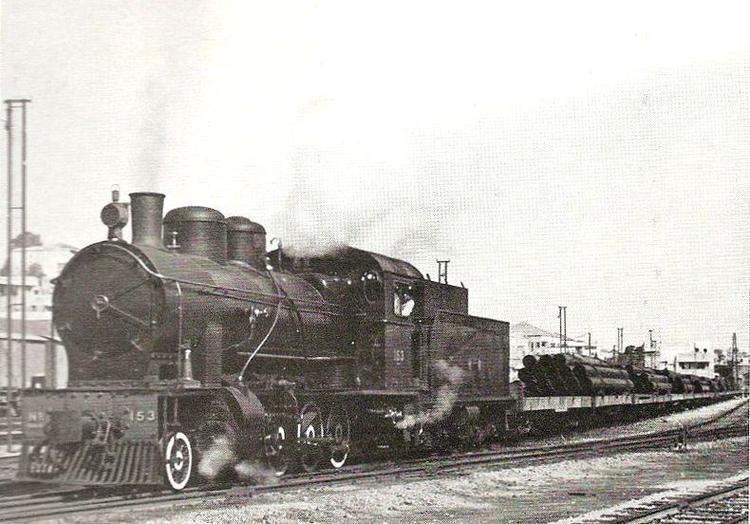
A railway had been suggested in 1864 to relieve the suffering of the Hajis on their 40-day journey through the wilderness of Midian, the Nafud, and the Hejaz Mountains. About 20% of them commonly died from starvation, thirst and diseases. The railway was basically a sub project of the Berlin-Bagdad Railway and started in 1900 at the behest of the Ottoman Sultan Abdul Hamid II and was built by the German Civil Engineer Heinrich August Meißner and financed by the Deutsche Bank and strongly supported by the German Empire. A public subscription was opened throughout the Islamic world to fund construction. However in 1912 the Ottoman Empire was owing the Deutsche Bank 29 million Turkey Pounds. The railway was to be a waqf, an inalienable religious endowment or charitable trust. Before the construction, German military adviser in Constantinople Auler Pasha estimated that the transportation of soldiers from Constantinople to Mecca would be reduced to 120 hours. The Berlin to Baghdad Railway was built in the same time. The railways were interrelated and aimed to strengthen the authority of the Empire over Arab provinces. Another intention was to protect Hejaz and other Arab provinces from British invasion. Other than the Haydarpasa-Izmit line, the Hejaz Railway was the only railway the Empire built itself in its existence. Due to its reliance on charitable donation to cover costs, and mounting pressure from competing Britain and France, construction stalled, ending up taking significantly longer to finish than anticipated.
Arrival in Medina
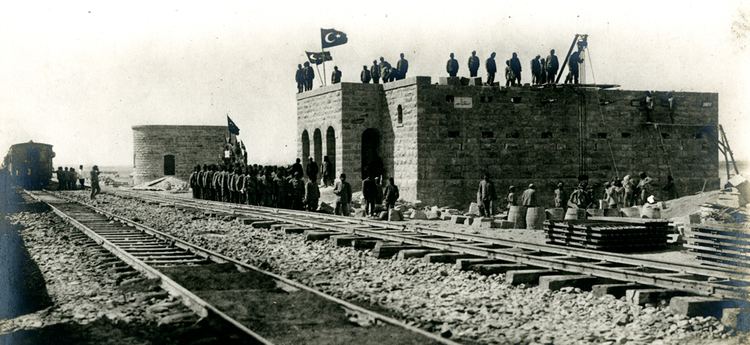
Under the helm of chief engineer Mouktar Bey the railway reached Medina on September 1, 1908, the anniversary of the Sultan's accession. Compromises had to be made in order to finish by this date, with some sections of track being laid on temporary embankments across wadis. In 1913 the Hejaz Railway Station was opened in central Damascus as the starting point of the line.
Attacks on the railway
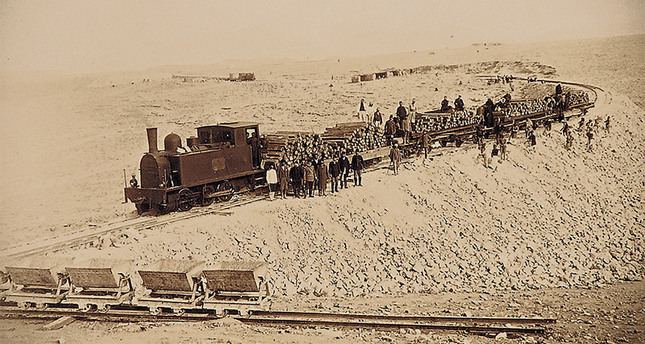
The Emir Hussein bin Ali, Sharif of Mecca viewed the railway as a threat to Arab suzerainty, since it provided the Ottomans with easy access to their garrisons in Hejaz, Asir, and Yemen. From its outset, the railway was the target of attacks by local Arab tribes. These were never particularly successful, but neither were the Turks able to control areas more than a mile or so either side of the line. Due to the locals' habit of pulling up wooden sleepers to fuel their camp-fires, some sections of the track were laid on iron sleepers.
World War I

During World War I, the German Army produced shale oil from the Yarmouk oil shale deposit to fuel locomotives operating on the railway. The line was repeatedly damaged in fighting during the war, particularly at the hands of the guerrilla force led by T. E. Lawrence during the Arab Revolt, which ambushed Ottoman trains. The Turks built a military railway from the Hejaz line to Beersheba, opening on October 30, 1915.
World War II
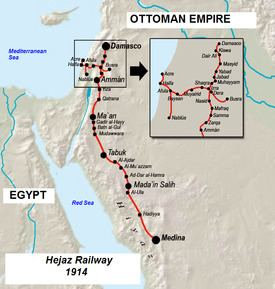
In World War II the Samakh Line from Haifa to Deraa at the Syrian border and to Damascus was run for the Allied forces by the New Zealand Railway Group 17th ROC from Afula, with workshops at Deraa and Haifa. The locomotives were 1914 Borsig and 1917 Hauptman models from Germany and Breda from Italy. The line, which had been operated by the Vichy French, was in disrepair. Trains over the steep section between Samakh (now Ma’agan) and Derea were 230 tons maximum, with 1000 tons moved in 24 hours. The group also ran 60 miles (95 km) of branch line including Afula to Tulkarm
The 1960s
After the fall of the Ottoman Empire in 1920 the railway did not reopen south of the modern Jordanian-Saudi Arabian border. An attempt was made in the mid-1960s, but this was abandoned due to the Six Day War in 1967.
Current status
Two connected sections of the Hejaz Railway are in service:
Workers on the railway have restored many of the original locomotives: there are nine steam locomotives in Syria and seven in Jordan in working order. Since the accession of King Abdullah II relations between Jordan and Syria have improved, causing a revival of interest in the railway. The train runs from Qadam station in the outskirts of Damascus, not from the Hejaz Station, which closed in 2004, pending a major commercial development project. On 4 February 2009 the Turkish Transport Minister Binali Yildirim said in Riyadh regarding plans to rebuild the railway line:
The plan envisages restoration and modernization of the railway line by the Turkish government within its territory, while it calls on Syria and Jordan to rebuild their sections of line.
...
On the Saudi side, they do have an ambitious plan to set up railway projects,
...
So, when these four countries (Turkey, Jordan, Syria and Saudi Arabia) come together, the entire project would be completed.
Small non-operating sections of the railway track, buildings and rolling stock are still preserved as tourist-attractions in Saudi Arabia, including the Medina Terminus, restored in 2005 with railway tracks and locomotive shed. The old railway bridge over the Aqiq Valley though was demolished in 2005 due to damage from heavy rain the year before. Trains destroyed during the Arab Revolt of 1916-1918 can still be seen where they fell.
Israel Railways partially rebuilt the long-defunct Haifa extension, the Jezreel Valley railway, using standard gauge, with the possibility of someday extending it to Irbid in Jordan. The rebuilt line opened from Haifa to Beit She'an in October 2016.
In 2009, Jordan’s transport ministry proposed a 990-mile (1590-km) US$5 billion rail network, construction of which could begin in the first quarter of 2012. The planned network would provide freight rail links from Jordan to Syria, Saudi Arabia and Iraq. Passenger rail connections could be extended to Lebanon, Turkey and beyond. The government, which will fund part of the project, is inviting tenders from private firms to raise the rest of the project cost.
In 2008 the "museum of the rolling stock of Al-Hejaz Railway" opened in Damascus Khadam station after major renovations for an exhibition of the locomotives. Trains run from Khadam station on demand (usually from German, British or Swiss groups). The northern part of the Zabadani track is no longer accessible. There is a small railway museum at the station in Mada'in Saleh and a larger project is the "Hejaz Railway Museum" in Medina, which opened in 2006.
